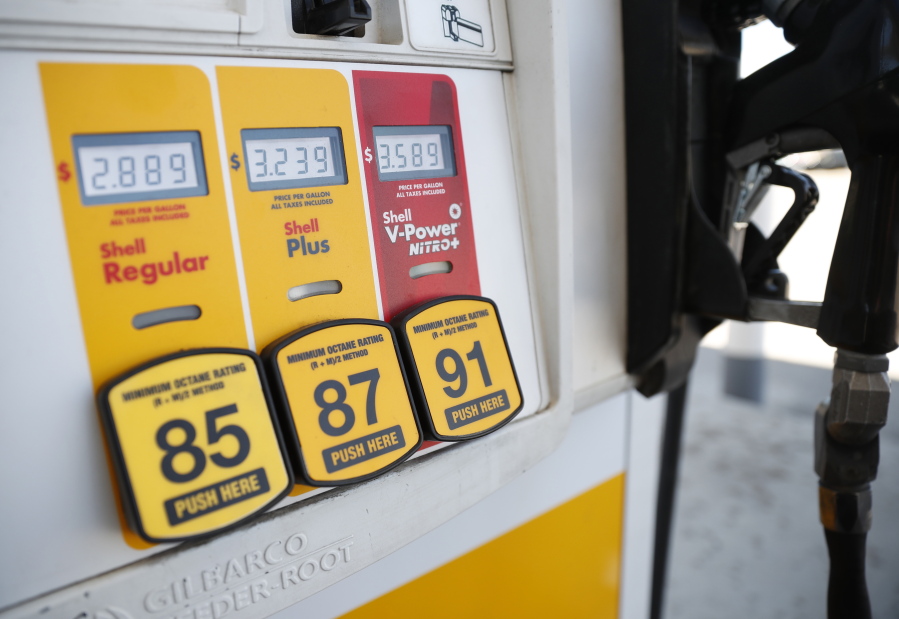LONGVIEW — With tightening gasoline stocks and seasonal refinery maintenance, gas prices will continue to rise in Washington and across the nation, according to AAA.
At $3.51, the state’s average price per gallon is well above the national average price of $2.88, according to AAA. For diesel, Washington buyers are spending about $3.42 per gallon on average, compared to $3.10 nationally.
Area residents could get gas as cheap as $3.35 per gallon at Minit Shop and Beachway Market on Wednesday, according to gasbuddy.com. But on average, local drivers are paying about $3.56 per gallon, higher than even the state average.
Lea Rehak, a Carrolls resident, filled up the tank in her Kia Soul on Wednesday at the Astro Express Mart. She said the rising prices were “why I’m at the Express. It’s one of the cheapest prices in town,” at $3.39 a gallon.
Rehak added that she traded her Trans Am for the Kia because it gets more than double the miles per gallon.
Regular fuel prices are up about 20 to 40 cents from a month ago, when fuel cost $3.16 per gallon on average in the state and $2.69 per gallon on average nationally.
Jennifer Cook, spokeswoman for AAA of Washington, said Washington gas prices will continue to rise but won’t reach $4 a gallon this summer if “nothing happens to disrupt the system.”
“For the most part our inventories are good, and our refineries are refining a march larger capacity than they ever had. … But again, things happen, and it’s hard to predict,” Cook said.
The current increase in prices is caused by ongoing refinery maintenance, Cook said. Usually maintenance season “wraps up” around April, but this year some repairs are taking longer than expected, and some Western refineries are doing additional “unplanned” maintenance, Cook said.
“That’s why the whole West Coast is seeing higher prices, because our inventories have continued to drop for about six weeks,” Cook said.
Prices also tend to be higher along the West Coast in general, with all of the region’s states consistently landing in the top 10 list for most expensive fuel, according to AAA. Washington currently sits at number 3, below California ($4.08 average) and Hawaii ($3.63 average).
Up from last spring
Washington’s current prices are also about 20 cents higher than they were this time last year, while the national average is about 7 cents higher. However, Cook said comparing year-to-year doesn’t always “show the full story” because when maintenance season starts and ends is highly variable.
Gas prices typically peak around July and August, Cook said, but last year Washington saw its highest prices in October.
Rising prices aren’t unusual during this time of year, though. Cook said prices typically rise starting as soon as mid-February, when refineries slow their production and begin maintenance and switch from winter blend fuel to more expensive summer blend.
Cook said gas prices are likely to continue their upward trend and will probably remain volatile during ongoing refinery maintenance. Based on trends from the last four years, they’ll probably plateau, then start declining in July or August, she said.
Longview resident Rick Fultz stopped at the 15th Avenue Safeway on Wednesday to get gas for his pickup. A disabled Vietnam veteran on a fixed income, Fultz said the spike in prices “takes away from something else, such as food or travel.”
Rising gas prices also strain some residents’ wallets because stores charge more to cover the increased cost of transporting goods, Fultz said. He added that with rising prices, he plans to eat out less often and will probably go to the beach only once this summer, as opposed to taking five or six trips.
“It just costs too much,” Fultz said.
Other local drivers agreed that higher gas prices change their daily routines. Rehak, the Carrolls resident, said she tries to complete all of her “in-town” errands in one trip. And Aaron Plampin of Longview said he skipped out on a friend’s barbecue in Castle Rock last week because gas was too pricey, and he commutes to his job at ilani in Ridgefield.
“It kind of sucks, but it just seems like as a member of the general public, you don’t have a lot of control over it,” said Plampin as he topped off his tank at Safeway on Wednesday.
River Cities Transit Manager Amy Asher said the local bus system typically sees a rise in riders as gas prices increase. For example, RCT had its highest volume of riders (almost 3,500 more than its 2018 annual average) last October, when gas prices peaked for the year.
The RCT vehicles are part of the city of Longview’s 370-vehicle fleet, said Keith Walling, fleet manager. Walling’s team plans for fluctuating gas prices in its two-year budget by researching cost estimates for “where the prices are going to go” over time, he said. Up slightly from last biennium, the 2019-2020 budget is based on an average annual price per gallon of $3.70 to $3.80, Walling said. Despite the recent rise in prices, the city fleet budget is still in “pretty good shape” because of lower prices earlier this year, Walling said.
Cook said the gas prices can vary dramatically, and they can be difficult to predict. Prices have been “fairly steady” over the last four years, but “it takes just one or two things to happen in the world … and the whole system can be significantly impacted,” she said.
Unexpected spikes in prices in the past have been “a bit of a struggle for us,” Walling said.



